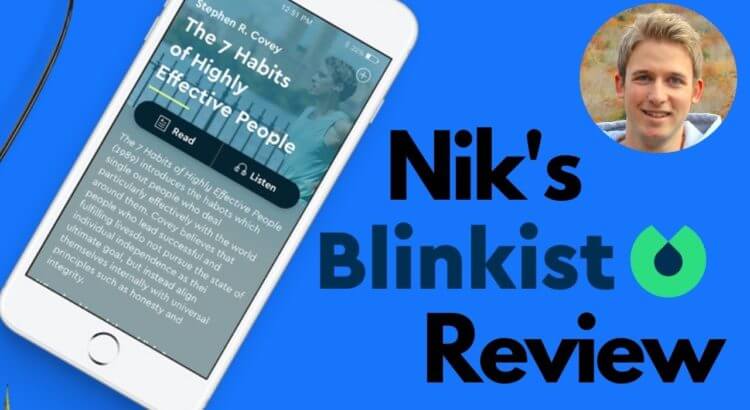How good is the Blinkist app? Is it useful? What does it feel like as a paying customer? And what about pricing? Does it hold up against other book summary services? The goal of my Blinkist review is to answer all those questions for you and more.
If you prefer to watch a video, you can see my live walkthrough of the Blinkist app below. This includes an analysis of its pros and cons and the price.

For an extensive review of the Blinkist app in written form, read on below or jump to any section using this table of contents:
Table of Contents
- Quick Summary of My Blinkist Review (FAQ)
- What are the Pros and Cons of Reading Book Summaries (in General)?
- How Does It Feel to Use the Blinkist App?
- What are the Main Features of the Blinkist App?
- Recap: User Experience on Blinkist
- What are the Pros & Cons of the Blinkist App Specifically?
- What are the Best Books on Blinkist?
- Recap: How Useful Is the Blinkist App?
- How Much Does Blinkist Cost?
- How Much Does Blinkist Offer Compared to Other Book Summary Services?
- Recap: Is Blinkist worth it?
- Conclusion: My Blinkist Review
- Other Reviews
If you want to come back to it at any time, just hit the little up arrow icon on the bottom right corner of this page.
If you want more information about Blinkist the company, details of individual features, and a walkthrough of the web app and how it feels compared to the app, check out my Blinkist Explainer Guide.
For this review, we’ll start with a quick summary where I give you brief answers to the most important questions.
Quick Summary of My Blinkist Review (FAQ)
- Is Blinkist app free? Yes, but as a free user, you can only read “the daily pick,” which is a random book summary.
- What’s it like to use Blinkist app? The user experience is simple, easy, and fast, thanks to Blinkist’s minimalistic interface, focused features, and sleek design. It’s geared towards reading and listening, which are its main use cases.
- Does Blinkist work offline? Yes. The summaries you add to your library will automatically be downloaded in text format. You can also download audios, even automatically, and delete them again after you’re done listening.
- How many books are on Blinkist? There are over 7,000 books in the Blinkist library and the team adds about 40 new titles per month.
- How much does Blinkist cost? The monthly pricing is $12.99, but if you buy the annual plan, you’ll get 50% off. If you use an affiliate link like ours, however, you can get another 35% off, putting the final price at $4.33 per month (that’s less than $0.15 per day). You can do so here.
- Is Blinkist worth the money? I think so. It’s the cheapest book summary service in absolute terms, costs less than a coffee a day (or in some places even a month!), offers great value for the money, and beats most free book summary sites.
If this is all you’ve wanted to know, and you now want to go right ahead and start a completely risk-free 7-day trial of Blinkist, you can use the button below to get started (and secure an extra 35% off should you decide to keep your subscription).
You’ll also support Four Minute Books at no extra cost to you, as we’ll receive a small commission for referring you. Thank you! If you haven’t made up your mind yet, just read on for the rest of our detailed Blinkist review.
What are the Pros and Cons of Reading Book Summaries (in General)?
When reviewing a tool or service, most people immediately jump into what they like and don’t like. That’s a mistake, especially when looking at one of many services in a particular category. In this case, book summaries.
The concept of a book summary itself has some specific advantages and disadvantages. Naturally, these will transfer to Blinkist and any other book summary service. You can’t really blame a particular company for them.
Let’s first look at those, so we can better pinpoint the unique pros and cons of Blinkist later.
Pros of reading book summaries:
- You’ll skip all unnecessary information. This is especially helpful for books that only make one or a few good points. It also helps you avoid poor books altogether.
- You can learn about more and different topics faster. Instead of being stuck on one book about meditation for a month, you can read a summary in a few minutes. Then, you can jump to the next mindfulness book or a new topic altogether.
- You’ll likely remember more without taking notes. Since book summaries center around facts and short ways to illustrate them, you’ll likely come away from one summary with 3-5 things you’ll remember. If you read a full book without taking notes, it’s hard to properly memorize anything.
Cons of reading book summaries:
- You’ll lose most of the story and humor of the book. This is bad, because it makes reading fun. Depending on how much you connect with the story, it also helps you remember a lot, even if you might have to take notes.
- You will miss out on big ideas and spontaneous insights from truly great books. The best books hit hard with every page. It’s impossible to transfer all of their knowledge into a summary. Some books you just have to read in full to get the most out of them.
- Due to a lack of context, you might interpret facts the wrong way. Sometimes, a summary states an idea one way, whereas the context of the book sets it up in another. But because that context is now missing, you’re interpreting the idea differently and thus get an impression the author didn’t want you to have.
- You are now trusting not just the author of the book, but also whoever wrote the summary. If the summary writer does a bad job, you lose. For example, they might fail to include an important story and so you won’t remember a crucial fact.
Again, these apply to all book summaries and the services that provide them. So with those in mind, let’s turn our attention to the Blinkist app user experience.
How Does It Feel to Use the Blinkist App?
First, the Blinkist app is available for both iPhone and Android. Downloading the app is free. You can sign up using your email address or Facebook account. When you open the app for the first time, you’ll get a short tutorial of how everything works.
One of the first things you’ll notice is that the app only has three tabs for you to choose from:
- Discover. This is where you can explore their library and find new titles.
- Library. Here, you’ll have access to your personal selection of books.
- You. This is where your settings and saved highlights are.
This is brilliant, because it makes navigating the app and choosing what to do really easy. Let’s look at the individual tabs.
1. The Discover Tab
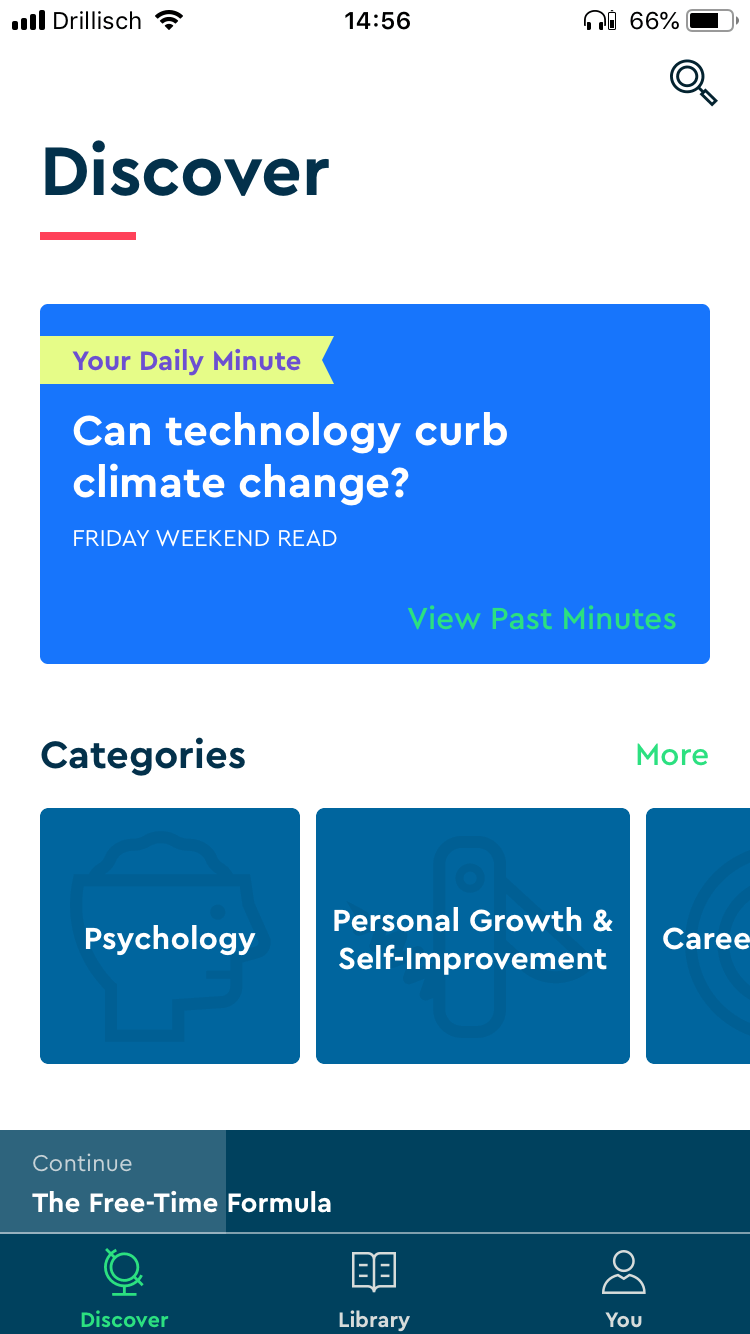
There are seven ways to find new book summaries inside the Blinkist app:
- You can search for a specific title, author, or keyword.
- The Daily Minute is a short introduction to the free book summary of the day.
- You can browse their 27 categories.
- The app generates personalized reading recommendations for you.
- There are multiple curated book lists from experts and authors.
- Trending blinks are what’s popular right now.
- The “New” section shows you the most recently added titles.
Since they have multiple ways of exploring, you can both find specific books and topics you’re looking for and randomly find new things.
2. The Library Tab
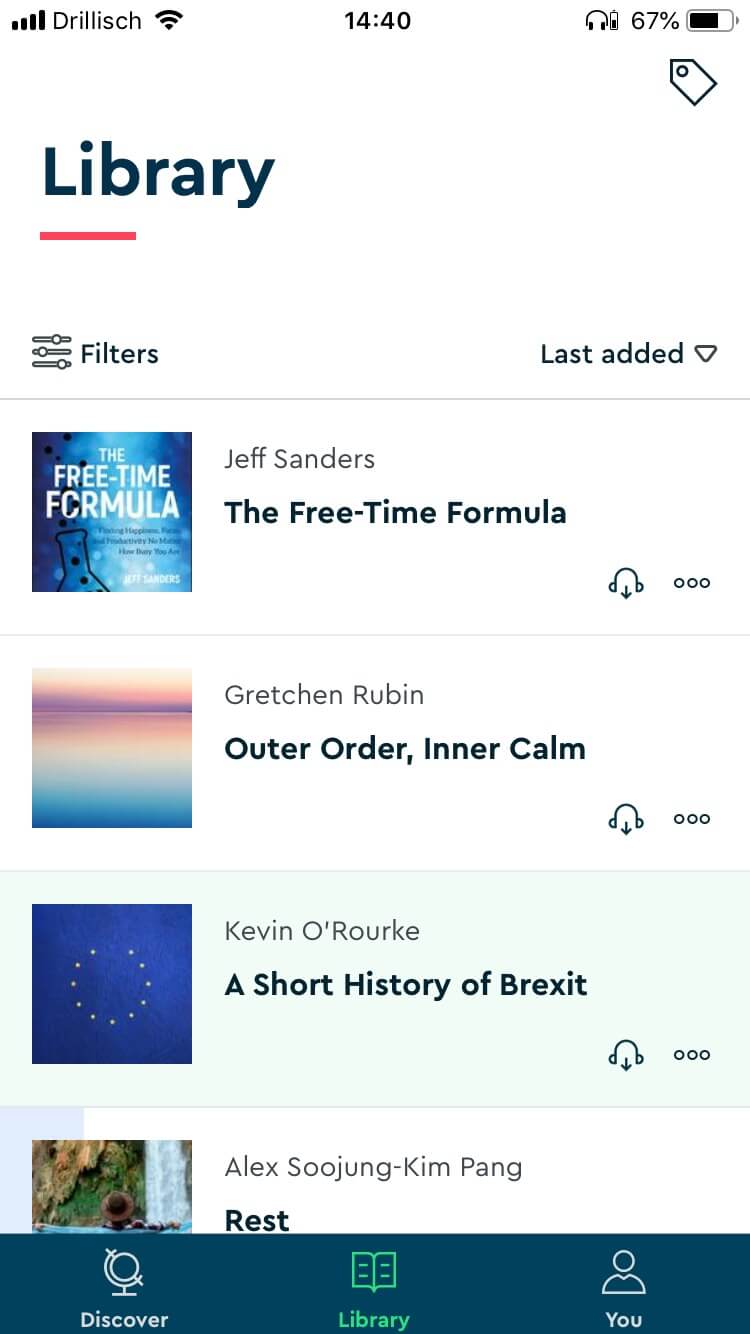
This is the central tab, the main view, the homepage, if you will. Your library is a list of all the summaries you’ve saved to read, which you can do in all discover modes using the ⨁ (plus) icon.
You’ll see a blue progress bar for all the books you’ve started and a green bar for all the ones you’ve completed. You can also filter your library for only audiobooks and by how much progress you’ve made. Finally, you can sort it by the books you’ve most recently added, opened, how much progress you’ve made, and alphabetically.
You can even create your own tagging system, save books as favorites on your profile, or download the audio for any book with one tap. The text summaries of all books in your library will be downloaded automatically, so you can always read them offline.
Here, you will also see a small, dark blue banner at the bottom, prompting you to continue reading your last summary where you left off. The library is from where you’ll start most of your reading journeys inside the app.
3. The You Tab
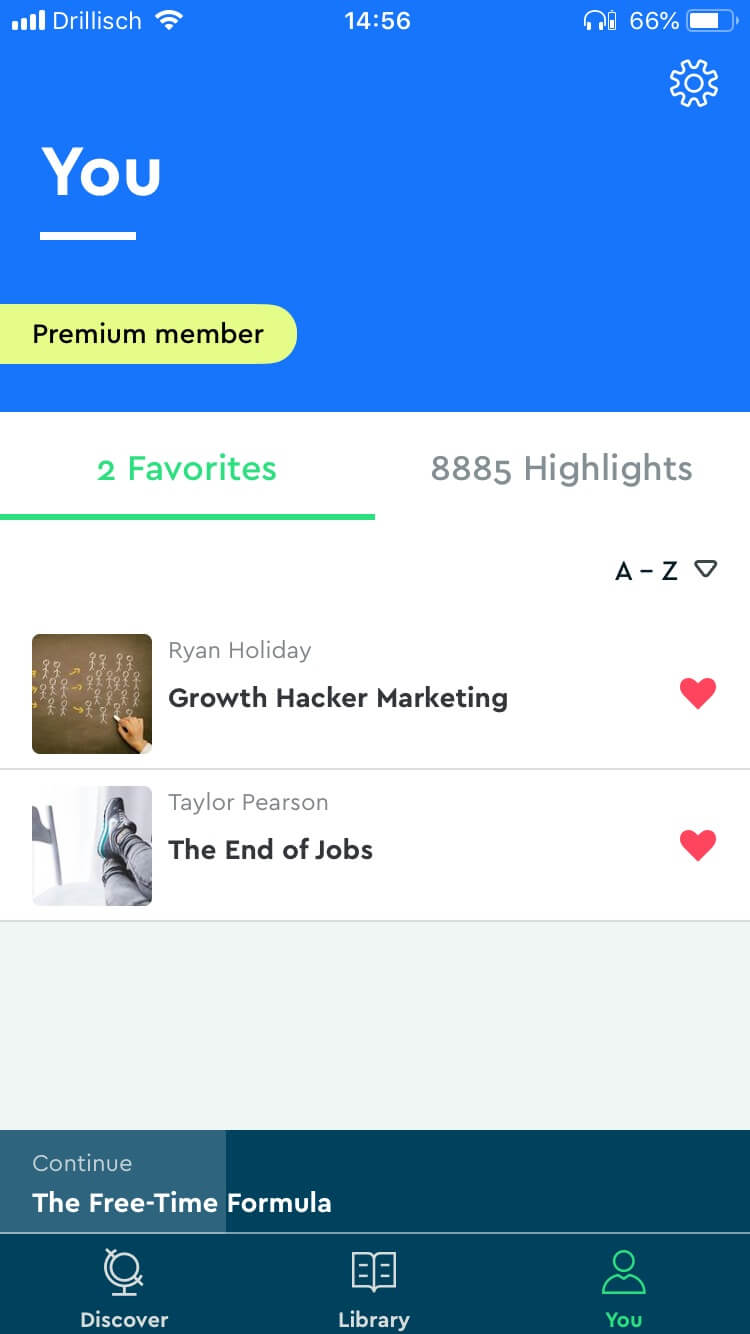
This tab is a very simplistic profile. It only shows a list of your favorite books (which you control via the ❤︎ (heart) button or by using the three dots icon in your library) and your highlights.
Your favorites list is a way to filter books even more, but I personally don’t use this feature, as I find the library does enough of that.
Your highlights are sorted by book and, if you tap on one, you’ll see which blink each one is from. You can also share them directly to Facebook, Twitter, WhatsApp, email, and many other services from here.
Finally, this is where you’ll find your settings. You can switch languages (they have German and English), activate email notifications for the Daily Minute, and choose how you want to download audios. There’s an option to auto-download, to turn off mobile data for it, and even to auto-delete audios after you’re done listening.
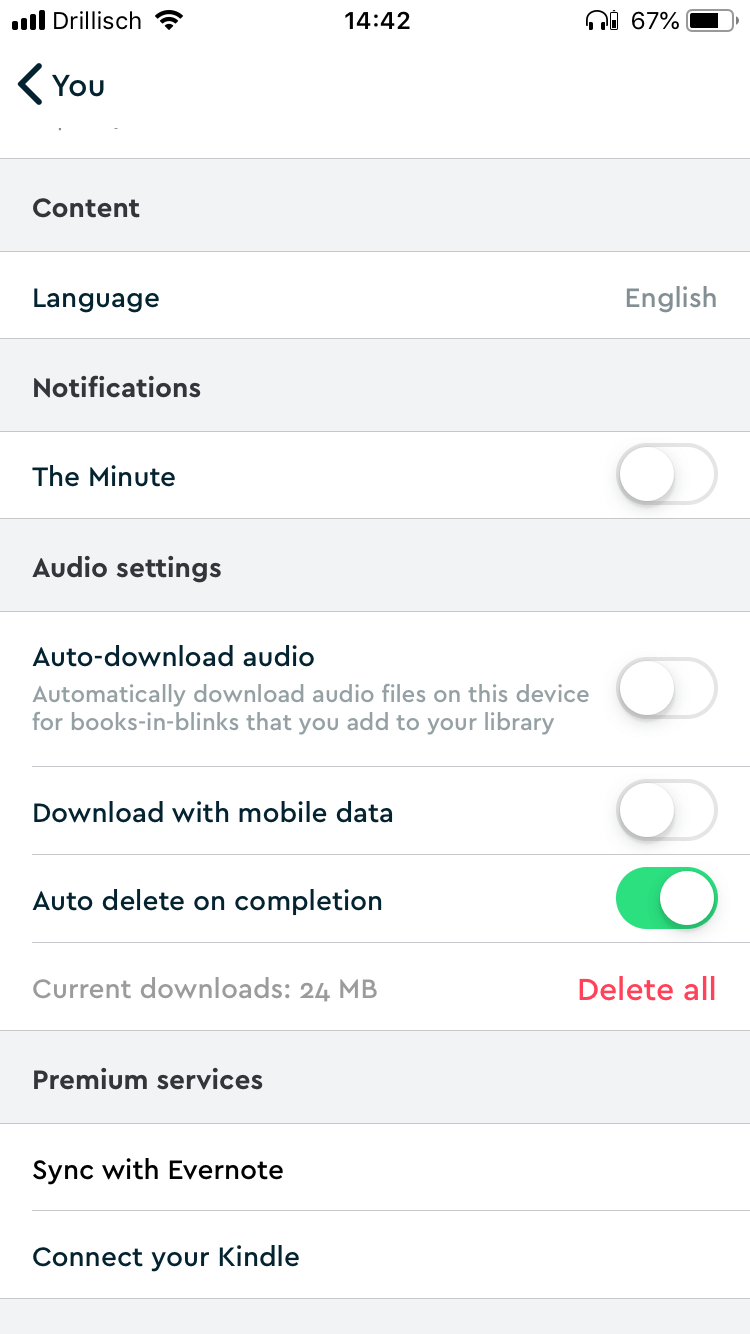
This also where you can sync your profile with your Evernote account and connect your Kindle. The first allows you to save all your highlights in an Evernote notebook and make them searchable. With the second you can send book summaries to your Kindle, save them forever, and take them anywhere.
As you can see, moving around the app is very easy to do thanks to its structure. Let’s see how it feels to use the main features: reading and audio.
What are the Main Features of the Blinkist App?
There really are only two use cases for the Blinkist app: reading summaries and listening to them. But what does that look and feel like?
1. Reading book summaries
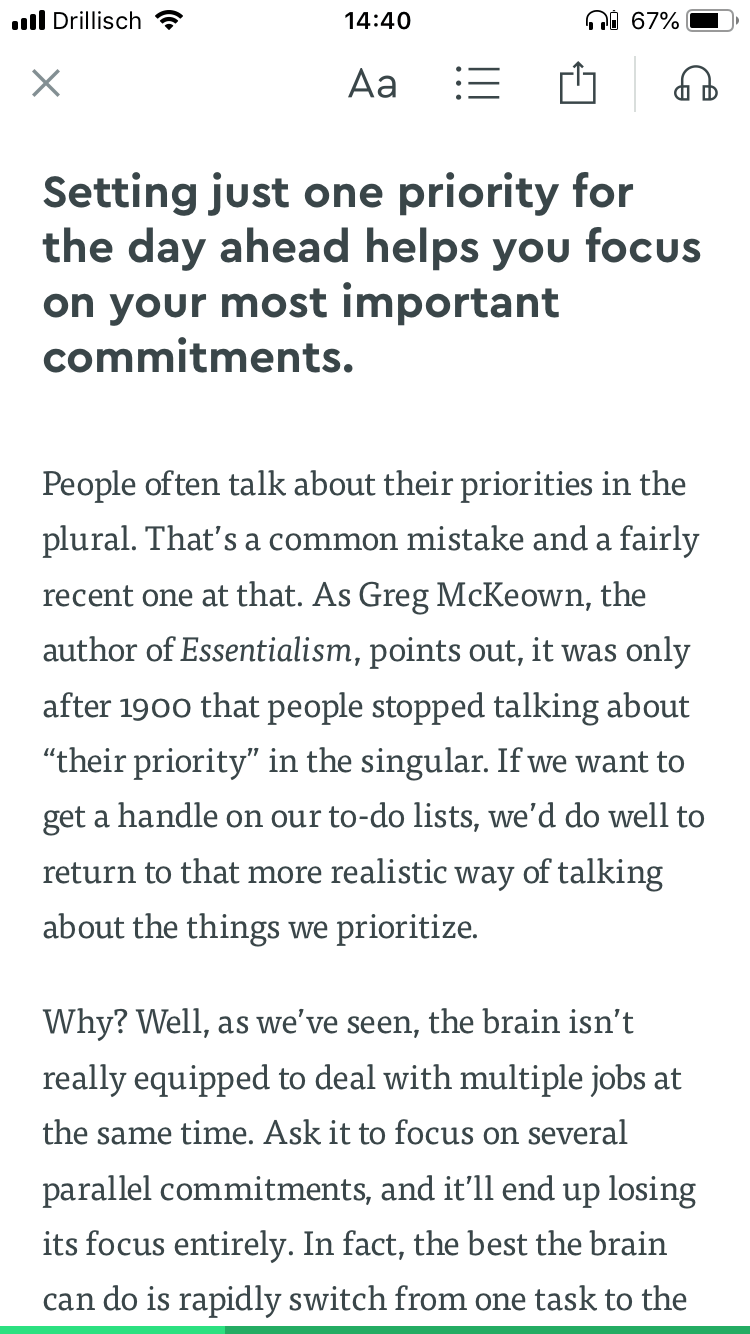
When you tap on a book inside your library, you’ll see a brief overview along with the option to either read it or listen to it. If you tap on “Read,” you’ll be taken to the first ‘blink,’ which is what Blinkist calls the pages of their summaries. It describes what you can get out of reading the summary.
Then, you can swipe from one key highlight to the next. You’ll see a progress bar at the bottom and you can highlight any part of the text that speaks to you. There’s also a table of contents, a toggle to adjust the font size or switch to white-on-black mode (rather than the default black-on-white), and a button to quickly switch to audio mode.
In between blinks, you’ll sometimes see nuggets of wisdom from the book, which is a nice goodie. The final blink is always a summary with some actionable advice. Then, you can mark the title as finished and go back to your library. Easy peasy!
2. Listening to audio book summaries

When you hit “Listen” in the book overview, you’ll go to the audio player. The blinks of that book will now play one after another until you’ve finished the whole summary.
You can also enable autoplay at the bottom of the screen, which will proceed to play all the books from your library in a row. If you swipe left, you can change the order of books in your queue, too. When you enable “Offline mode,” the app will only play audios you’ve previously downloaded.
The audio player itself is very easy to understand. The key takeaway of each blink is shown in the middle and the controls allow you to skip 15 seconds forward and backward, as well as increase or decrease speed. The minimum is half speed, the maximum is twice as fast. That’s it, plain and simple, just like using Spotify or your phone’s standard music player!
Recap: User Experience on Blinkist
Blinkist truly wants to save you some time. You can feel it. The design is very minimalistic, and that’s on purpose. Everything is concise and to the point. They don’t give you many options and that’s a good thing.
In fact, they’ve removed several features from previous versions, and I think it serves a purpose. Blinkist wants you to be focused on one thing and one thing only: learning from books through reading and listening.
That’s why there are no cluttered sidebars, no fancy buttons, no advertisements. The user interface reminds me of Medium. It’s extremely focused on giving you the best reading and listening experience possible. Nothing more, nothing less.
This also means navigation is easy, you can hardly do anything wrong or go somewhere you don’t want to be inside the app. Loading times are fast, both on the phone and web app, and thanks to offline reading and downloading audios, you don’t even need an internet connection at all times.
So much for the user experience. Now let’s talk pros and cons.
Thank you for reading this far! Ready to jump in and try Blinkist? Use the button below to get started and snag a sweet 35% off should you decide to keep your subscription after your totally risk-free one-week trial. Comes with free support of Four Minute Books at no extra cost (we’re an affiliate). If you want to know more first, read on for the remainder of our review.
What are the Pros & Cons of the Blinkist App Specifically?
Now that you know what it feels like to use the app, let’s talk about some of its ups and downs. Again, remember that all book summaries have advantages and disadvantages, but these are specific to Blinkist’s service:
Pros of using the Blinkist app:
- The book summaries are complete. You don’t get just a few ideas or important concepts from a book, you get all of them.
- It’s very easy to consume content and learn. The app is simple to use, convenient to navigate, and a child could figure out how to access the main features, reading and listening, within minutes.
- Highlighting helps a lot with remembering facts from summaries. This is an underrated feature, as it can make a big difference in how much information you retain, but you also have to use it to get the benefits.
- The audio experience on Blinkist is seamless. You tap, it plays, you listen. Perfect for learning during long workouts, your commute to work, or while cooking or cleaning your house.
Cons of using the Blinkist app:
- Humor and most emotion are stripped away almost completely from the book. Some writers make a point to capture some of the book’s unique spirit in their summary. Blinkist doesn’t, it’s very geared towards facts.
- Reading many summaries in a row can feel repetitive and boring. That’s mostly because of the lack of story, and it’s why I’d recommend reading 1-2 summaries a day, no more.
- Some summaries are too short for the book they represent. I’ve come across summaries that only had three or four blinks, but the actual book was really long. I suspect those will miss many important points.
- There is no scrutiny towards individual books. The Blinkist team doesn’t review, critique, rank, or fact-check any of the books. That means these jobs are still yours to do.
I’ll give you my final thoughts on how these weigh against one another at the end of this review, but for now, I’ll let you be the judge.
Next, let’s look at some of the content itself so we can get an idea of how useful the service might be for you.
What are the Best Books on Blinkist?
The single best way to get a feel for the content on Blinkist is to read today’s free summary. You can also listen to the audio. You’ll find both here. That said, here are 10 of Blinkist’s all-time most popular titles so you can see what kind of books they have:
- The 7 Habits of Highly Effective People by Stephen R. Covey. This all-time classic describes seven habits most successful people share and how to form them in your own life.
- Getting Things Done by David Allen. The default manifesto on productivity. A simple system with a few hard and fast rules to help you do your work.
- Thinking, Fast and Slow by Daniel Kahneman. In this book, you’ll learn about cognitive biases and how they shape – and sometimes distort – our perception and decisions.
- The Power of Habit by Charles Duhigg. This is one of the best books on making and breaking habits there is. Thanks to Duhigg’s habit loop, you can identify and change your behavior in the ways that you want.
- The 4-Hour Workweek by Tim Ferriss. If you want to be an entrepreneur, this is for you. Tim describes how he built, automated, and later even sold his company. More importantly, he gives you the tools and tactics to create your own in a way that funds your lifestyle without taking too much time.
- Influence by Robert Cialdini. One of the best books on how to interact and build relationships with other people. You can use this book to find friends, get a promotion, or find a compromise with your spouse.
- Drive by Daniel Pink. Pink dissects what motivates us, which is really helpful in finding work you love.
- Outliers by Malcolm Gladwell. By analyzing a few extreme cases, Gladwell manages to deliver a template of why products, ideas, and people are successful – or not.
- Mindset by Carol Dweck. There are two main ways to look at the world: you can either try and learn from everything (a growth mindset) or accept everything as is (a fixed mindset). Dweck helps us go from one to the other.
- Flow by Mihaly Csikszentmihalyi. One of the best books on creativity and happiness. It explains why we enjoy the activities we enjoy and helps us do more of them.
If you sign up for a free, 7-day trial, you can read all of the above. You can also get a sneak peek at their content by reading their free summaries on Four Minute Books. You can find them all in our index of book summaries.
Recap: How Useful Is the Blinkist App?
Blinkist has over 7,000 books in its database. The selection is also growing at about 40 books per month. That’s a true all-you-can-read buffet of book summaries. No matter whether you want to learn about growth hacking, stoicism, economics, entrepreneurship, habits, mindfulness, happiness, love, biology, history, or food, you will find the right book.
What’s more, thanks to cutting out the fluff, but giving you all the important ideas of a book, Blinkist also lets you decide what you want to learn from a book and how much. You can get just the main concept from a book like The One Thing, or browse all blinks and see how many sound new to you. If you find many interesting things, you can still buy the book. If not, you can be done with it or return to it later.
The purpose of Blinkist is to give you a factual analysis of the core message of a book, along with all its important points. And it really delivers on that promise. Therefore, you can use Blinkist both as a complement and supplement to books. Get the best ideas from books not worth reading in full and screen great ones before you commit to them.
Okay, time for the money talk. How expensive is this service?
Thank you for reading this far! If our book selection has made you curious, please use the button below to sign up for Blinkist. You’ll support this site at no extra cost in the process by automatically letting them know we’ve referred you, and we’ll get a small commission should you keep your subscription.
The trial lasts 7 days, however, and is completely free! And now, on to the rest of our Blinkist review: pricing and competitors!
How Much Does Blinkist Cost?
First, the Blinkist app is free to download and install. But with a free account, you can only read one summary each day: the daily pick. This is a set of randomly chosen blinks, so you can’t control what you’re reading. Full access requires a Premium subscription.
Blinkist offers a monthly and an annual plan.
For $12.99 per month (or the same amount in €, if you’re in Europe), you get unlimited access to their content. That includes over 7,000 titles, including audio versions, shortcasts (summaries of podcasts), offline reading and downloading, highlighting, as well as the ability to sync your highlights to Evernote or send summaries straight to your Kindle. That’s less than $0.50 per day and pretty cheap if you consider the “skill” you’re getting in return. But wait!
On the annual plan, you get 50% off, which means you’ll pay only $6.67 (or €) per month. That’s a steep discount. Even if you just use the app for six months, it’ll have paid for itself. Can it get any better? Actually, yes, it can.
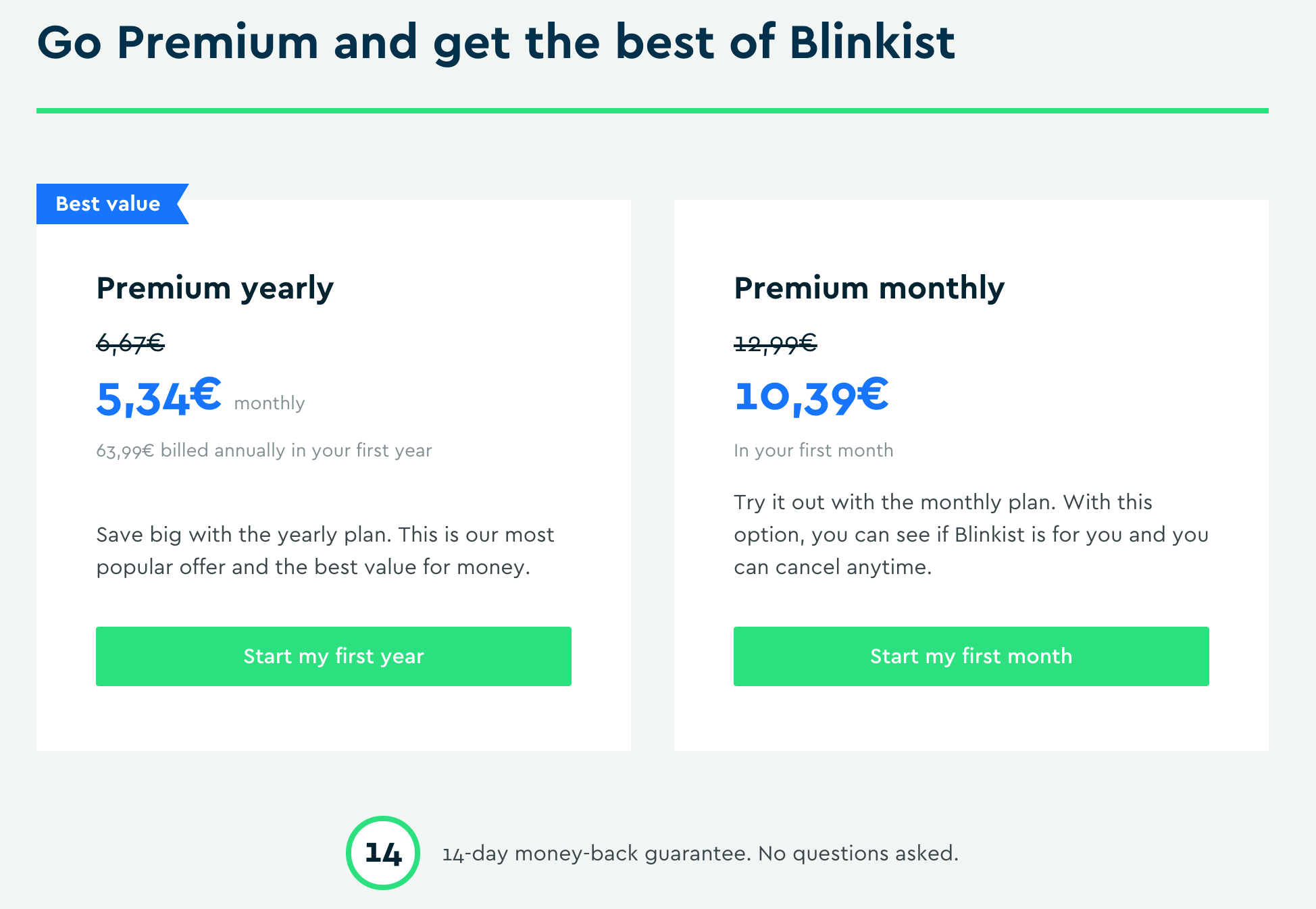
Four Minute Books is a Blinkist affiliate, meaning we can give you another 35% off if you use our link. In return, we’ll receive a commission for referring you to Blinkist as a customer. In the end, you’ll pay just $4.33 per month – less than $0.15 per day!
How Much Does Blinkist Offer Compared to Other Book Summary Services?
Generally speaking, there are two kinds of book summary services.
First, there are those offering free book summaries, like we do on Four Minute Books. This usually means affiliate links to the actual books are included in the content. Often, it’s just one or a few people running the site and sharing their notes.
Second, there are paid book summary services, like Blinkist. These either charge you per summary or you’ll have to pay a monthly fee to access all their titles. Usually, it’ll be a team creating the content in multiple formats.
We wrote an in-depth article looking at the 8 best Blinkist alternatives overall, but for now, let’s look at some of the most popular ones in both categories and how they stack up against Blinkist.
Blinkist Alternatives (Free Book Summary Services)
- Optimize by Heroic. Brian Johnson used to run Optimize.me as a paid service. Over 250,000+ people use it. However, he recently raised money, turned his company into a B Corp (a public benefit for-profit corporation), and made the app free! Before, it used to be ~$100/year. Optimize offers over 600 Philosopher’s Notes, structured 6-page PDFs of some of the world’s best titles. It also includes audios, videos, and a lot more. Great free book summary app!
- The Power Moves. Lucio is incredibly dedicated to objectivity and putting out quality content. I didn’t count the number of summaries in his list, but it seems to be the only free one that rivals our nearly 500 titles.
- NJlifehacks. Nils and Jonas are great, positive guys, and they put a lot of hard work into their writing. They even create custom images for their summaries. Awesome!
- Actionable Books. With over 1,000 summaries, this is technically the largest list, but the articles don’t really feel like summaries. They all share just one big idea and then two more random insights. I’m not convinced of this structure. I know our own 3-lesson format is sometimes limited, but this even more so.
- James Clear. King James barely needs an introduction. He’s one of the most prolific researchers and writers on the science of habits. He’s summarized many popular books in 3 sentences.
- Sam Thomas Davies. I’ve known Sam for years now, and he dissects the psychology of our brains like no other. He also has 100+ book summaries which he’s organized perfectly by category.
- Nat Eliason. Nat is one of the great experimenters of our time, covering everything from health to tech to sex to entrepreneurship. His book notes are more like highlights, but combined with his ratings they’re very useful.
- Derek Sivers. After selling his business, Derek is now living a quiet life as a thinker, writer, developer, musician, and whatever else he wants to be. He has notes on over 250 books too. Respect!
Other free services, like Spark Notes, CliffNotes, and WikiSummaries are more concerned with textbooks and classic literature, to help you study for school.
Considering you only get one summary per day as a free Blinkist user, many other services offer far more free content. At the same time, these services rarely provide summaries that are as complete or in-depth as Blinkist’s, precisely because they are free. Often, they also have less content overall, as Blinkist’s team of 60+ people can put out way more summaries than any one- or two-person blog.
If you’re only reading a few summaries a month or don’t care about the randomness of Blinkist’s daily pick, free might do the trick for you. But if you want more, a paid service is the way to go.
Blinkist Alternatives (Paid Book Summary Services)
- Headway. This is a relatively new app, offering bite-sized learning in a variety of formats. They only launched in 2019 but already boast over 12 million users, making them a serious Blinkist competitor. By using a combination of quotes, summaries, audio, and graphics, they make it really easy for you to make learning a habit. At $90/year, it costs about the same as Blinkist.
- Shortform. A few years ago, I saw a guy named Allen Cheng post incredibly detailed book summaries on his blog. Now, his work has become the foundation of Shortform, a full-scale book summary service trying to offer the most detailed, chapter-by-chapter book summaries of them all. You can read our full review of Shortform here.
- Instaread. Another solid Blinkist competitor with over 2,000 books summarized, a sleek-looking app and format, and a nice level of depth and storytelling to their content. It’s about the same price as Blinkist too, and has some neat goodies like swiping left and right on quotes from books. Read our full review here.
- getAbstract. With over 18,000 books, this is probably the biggest book summary service in the world. They have a cool student offering (free for one year, then 59 €/year), but the regular Pro and Enterprise licenses are really expensive (299 € and more per year). You can read our in-depth review of them here.
- Uptime. This app offers 5-minute knowledge hacks for books, courses, documentaries, and even podcasts in extremely creative reading, listening, and watching formats. Starts from just $4/month! Read our detailed review here.
- Readitfor.me. This service is more geared towards busy professionals with its 12-minute video summaries and audios. It also costs $19/month, or $29/month if you want access to their masterclasses.
- FlashBooks. I’m not sure how many summaries this service has, but at $29/month after a $1-trial-week, it’s definitely expensive.
- Readingraphics. This service takes a more visual approach to reading with infographics for each books. However, for $19/month you only get 3 new summaries, which is a high price per piece of content.
- Scribd. Scribd aggregates and summarizes all kinds of content, from audiobooks to books to magazines to research papers. They also often host full-version PDFs of the originals. You can read our in-depth review here.
My friend Prakhar created a great list of even more services and tools, but I think these are the most relevant ones. If you ask me, Instaread and getAbstract are the best alternatives to Blinkist, as they have a similar, if slightly more expensive price-to-value ratio, not factoring in any discounts. Optimize is probably the best free alternative.
If you want to learn from multiple books a week or even a day, I think Blinkist offers the best value for the money.
Recap: Is Blinkist worth it?
To figure out whether you should pay for a subscription, I like this thought experiment:
Imagine you could buy the skill of being able to read one book every single day. Just like in The Matrix, it’s uploaded right into your brain. How much would that skill be worth to you? $1,000? $10,000? $100,000? Whatever your number is, that’s what Blinkist should be worth to you.
Because with a Blinkist Premium subscription, you’re essentially acquiring this skill overnight. Instead of wasting lots of time on bad books and procrastinating on reading, you’ll read one set of blinks and digest all of the core ideas of an entire book in 15-20 minutes. Meanwhile, colleges charge $200,000 for a degree in which they barely teach you anything.
In my town, Munich in Germany, some cafés charge $7 or more for a single cappuccino or latte. Yet, for less than that, I can get a full month of access to over 7,000 book summaries and audios, all designed to do only one thing: make me smarter.
At $0.15/day, I pay ten times the money for my daily coffee. Maybe, you are too. If that’s not a no-brainer, I don’t know what is.
Thanks to Blinkist, you’ll save lots of time, be able to learn in situations where you usually couldn’t, remember more, and soak up knowledge about new topics faster. The pros easily outweigh the cons. Given that it is the cheapest book summary service in absolute terms, and offers great value for the money, I think Blinkist is worth paying for.
Conclusion: My Blinkist Review
Let’s briefly recap each section.
First, the user experience inside the Blinkist app is brilliant. It loads fast, the minimalistic design is simple to understand, it syncs between all your devices and you can always pick up right where you left off. The app gently steers you towards its two only true use cases: reading and listening to summaries of books.
Second, the Blinkist app is extremely useful and its pros outweigh its cons. Sure, the summaries are mostly fact-based and some of them aren’t perfect, but thanks to their completeness, you can pick up tons of ideas in a short time. Since the reading and listening experience is flawless, you’ll also remember a lot of what you read.
Third, Blinkist offers huge value for the money and is the cheapest book summary service in absolute terms. With over 7,000 summaries in its library and a price of only $0.15/day, Blinkist outshines most competitors. They have more content than most free summary sites and are cheaper than all other paid services. But even judged on its own, it’s an investment in yourself you won’t regret.
Here’s my final verdict: Use Blinkist as an extension of your usual reading and a complement to it, not a replacement.
You can skip the fluff of books with only a few good ideas, learn via audio in situations where you can’t read a book, and screen great titles before committing to reading them in full. That’s what this app is perfect for. If you read 1-2 summaries per day, you’ll also greatly speed up your learning overall. I highly recommend you sign up.
Thank you for reading my Blinkist review! I hope you found it helpful. If you like what you’ve seen and are excited to sign up, I’d appreciate it if you used our Blinkist discount code to get an extra 35% off and support us at no extra cost to you.
You can also sign up for a risk-free 7-day trial and make up your mind later. Thank you!
Whatever you do, I’m grateful you read this review and I hope Four Minute Books will help you become smarter.
Other Reviews
Looking for our other reviews of the most popular book summary apps, tools, and services? Here’s a list of all the reviews we’ve published so far:
- Academic Mastery With Roam Review 2024
- Audible Review 2024 – Is It Worth the Price?
- Audiobooks.com Review 2024 – Is It Better Than Audible?
- Blinkist Review 2024
- Blinkist vs Headway: Which One Is Best For You?
- Evernote Review 2024: Is It the Best Note-Taking App?
- getAbstract Review 2024
- Headway App Review 2024: Is It the Best Book Summary App?
- Instaread Review 2024
- Masterclass Review 2024: Is Masterclass Really Worth It?
- Scribd Review 2024 — Is It Worth It? (Everand Review)
- Shortform Review 2024: Is Shortform Better Than Blinkist?
- The 17 Best Reading Gadgets to Make Reading Easier & More Fun
- The 8 Best Free & Paid Alternatives to Blinkist (2024)
- Uptime Review 2024: Is This 5-Min Book App Worth It?
Last Updated on April 4, 2024
